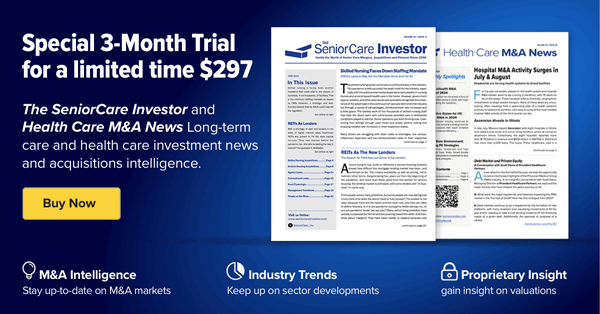The effects of the COVID-19 on the healthcare M&A market will be difficult to discern for some time. Dealmaking takes a few months at least, so most announced transactions today were set in motion before the pandemic hit. The first quarter essentially dodged a bullet, but the start of Q2 is a much more precarious situation for investors and private equity.
States are eager to loosen social distancing guidelines to boost the economy, but changing the public’s perceived risk of infection might not be so easy, so creating a rebound might prove a significant challenge. Hospitals and providers are still dealing with the flood of COVID-19 patients, cutting off revenues from elective surgery and other procedures. Lawmakers in Washington have promised over $100 billion in emergency funding through the CARES Act, but hospitals claim more is needed. It seems no one can agree on a course in these unchartered waters.
If April’s deal volume is any indication, the next few months are going to look bleak. Currently, only 97 deals are recorded in our database for the month. We expect more deals to eventually surface, but its the first time we’ve seen monthly deal volume dip below 100 deals in at least a few years.
The driver behind the sustained activity in 2018 and 2019 can be largely attributed to private equity firms and their portfolio companies (PE buyers). According to our 2020 Health Care Services Acquisition Report, in 2018 and 2019, PE buyers accounted for between 45% and 48% of transactions across the healthcare services sectors. Sector by sector, the influence becomes more apparent. In Behavioral Health Care, it was 68% of all deals in 2019, and in Physician Medical Groups, that number ticks up to 69%.
Thus, as PE buyer activity drops, so does the monthly deal volume. In April 2020, PE buyers accounted for only 16% of all deals, which is nearly half of the 31% reported in March 2020 and slightly lower than the 21% counted in April 2019.
Dollar volume isn’t the best indicator of market health, as most PE buyers keep a tight lip on values, but it’s interesting to report on nonetheless. In April 2020, PE buyers announced roughly $1.38 billion in spending, 31% of the monthly dollar volume (which was also considerably low overall, at $4.35 billion). In March 2020, PE buyers announced $5.6 billion in spending, 23% of the monthly total of $24.6 billion. In April 2019, these buyers accounted for only 2% of all announced spending, just south of $118 million.
PE buyers have hit the pause button for good reason. The Center for Medicare & Medicaid Services (CMS) recommended in March that non-essential medical, surgical and dental procedures be delayed during the conoravirus outbreak, which will most likely cripple physician groups financially, hurting potential future valuations if PE firms are looking to sell. Further, Congress had set aside $350 billion in the CARES Act for small business assistance for companies with 500 employees or fewer. Due to a set of standards called “affiliation rules,” which essentially treat each PE firm and their portfolio companies as one entity, those PE-owned physician groups and healthcare practices couldn’t qualify.
However, the near-future isn’t entirely grim. Private equity firms such as TPG Capital and Webster Equity Partners are still pushing along with their M&A activity, the former committing roughly $1.2 billion in the Behavioral Health Care space in April (more on that later).
And some recent acquisitions still highlight promising sectors for private equity buyers to invest their stocked-up dry powder. Genalyte, a portfolio company of CLI Ventures, announced the purchase of BaseHealth from HBM Partners. BaseHealth is a healthcare data analytics company whose platform incorporates all available health information about the patient, including diagnostic tests, in order to maximize the accuracy and utility of the test, which could prove to be incredibly useful as testing ramps up for COVID-19. Frazier Healthcare made moves into the Biotechnology sector, acquiring Dascena, which develops algorithms as predictive diagnostics and biomarkers for complex conditions.
Looking at the post-pandemic health care marketplace, financially distressed physician groups and standalone hospitals might seek to join larger organizations for some stability, which could result in a flurry of M&A activity.

